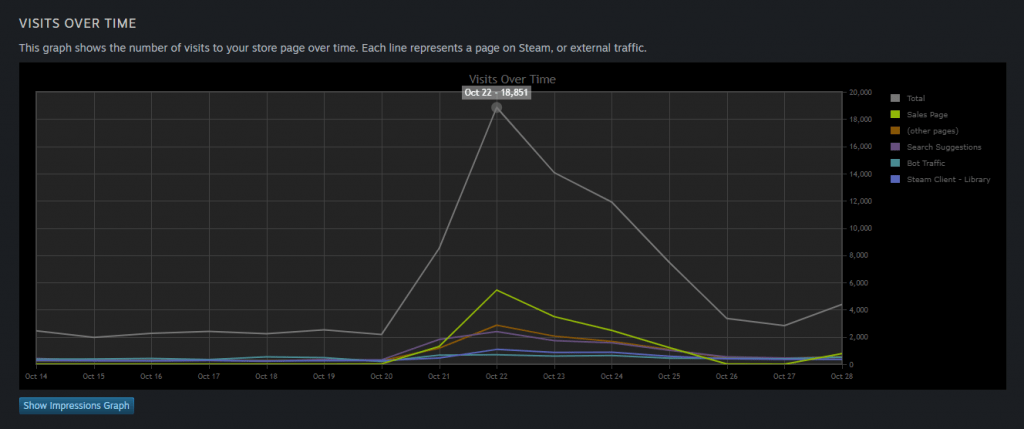
The Lady Afterwards postmortem
It’s useful to look back on projects that you’ve just completed and work out the good bits, the bad bits, and the stuff you’ve learned from doing it. So here’s a retrospective on Weather Factory’s latest game, occult warts and all.
Project synopsis
We started The Lady Afterwards in March 2021 when we had a surprise gap in Weather Factory’s production schedule. AK burned out and needed an indefinite time off work to recuperate. When you’re a two-person dev team and the ill person is the only one who can code, that’s a problem. So I needed to think of something commercially viable and interesting I could do as a solo developer over the uncertain time period AK might be off sick.
This seemed a good time to try making a Cultist Simulator tabletop RPG which we’d been talking about – mostly as a joke – for years. We decided to ship two versions: a premium physical boxed edition, and a more mass-market digital-only edition.
The project had four key aims:
-
-
- Provide Weather Factory with a marketing beat in an otherwise quiet year
- See if we could attract new fans from the TRPG community (particularly Call of Cthulhu and D&D)
- Test new physical merchandise
- Test high-cost merchandise. Was it out of our customers’ means? Could we make something actually worth a high price point?
-
The Lady Afterwards launched as a limited physical edition (£150) on 21st October, and as an unlimited digital release (£30) on 18th November. Aims 1, 3 and 4 have all been successes, and we’ll know how Aim 2 went in six months when we can realistically evaluate sales across physical and digital storefronts.
What went well
1. The physical edition couldn’t have sold out faster.
There were only 100 boxes for The Lady Afterwards physical edition. We sold them in sixty seconds with no press and no advertising. I had advertising planned – announcements to 23k-ish social followers and an email to a 20k mailing list, for example – but I never ended up sending those out, because suddenly all my carefully-planned calls to action didn’t mean anything. “Hey thanks for being on the mailing list / following us on [ social media channel ], here’s a thing you can’t have!”
We didn’t expect to sell out so quickly, but we had considered the possibility of selling out at some point. So we had 500 not-yet-made pre-order boxes ready to sell through SendOwl, a direct-sale platform, on this website. We pushed this live ASAP on launch night with a hand-wavey estimate that we’d probably ship in about three months but it wasn’t a promise. We sold out of all of those in 72 hours.
We regularly get emails from people asking if there are any more physical boxes available, and when the box will go on sale again. There’s clearly appetite for the physical Lady Afterwards box. It’s made a nice contribution to the Weather Factory coffers already, and we plan to release another 1,000 physical boxes for sale next year. 👌
2. We tried loads of new things, so we learned a lot.
Neither of us had ever made a physical commercial game before, though AK has a long history of releasing video games and I’ve run a successful merchandise shop since 2018. We’d never made a commercial TRPG before, though I played a bunch of Call of Cthulhu at university and AK has been writing and running TRPGs since he was eight. We’d also never converted one of our IPs (in this case, Cultist Simulator) into another medium (TRPGs), I’d never worked with PDFs properly, designed and printed books of the complexity of The Game Runner’s Guide, and we think we’re the first game studio to sell a digital TRPG through Steam (grossing £10k in three weeks, so far). Now we’ve done all this, we have experience, we have suppliers and process, and we’ll do it better next time.
The project also changed our company strategy. We weren’t sure if anyone would buy a physical box of stuff we made for £150 + shipping. That’s more than ten times the cost of Cultist Simulator. But so many people clamouring for a box meant we really were producing something prestigious, unique and attractive enough to merit the cost. This has changed our expectations of ourselves as a studio, will make us more accurate with price points and sales projections, and means we’re highly likely to offer similarly boutique products in future. We have several new plans in motion that have only happened because we experimented with The Lady Afterwards.
3. We produced a project we’re proud of.
The box looks beautiful, the game is 80 pages of well-researched 1920s Egyptian occultism, and the rules feel loyal to Cultist Simulator while respecting their new medium as a tabletop RPG. Designers and artists are always hypercritical of their work – you see all the flaws and the ‘could have beens’ – but even I thought it looked great when I saw the components together, tied with various ribbons, placed in various velvet bags and nestled into black shredded packing paper in its custom eco-box. I don’t think there’s anything else like this out there. The Lady Afterwards was inspired by the Horror on the Orient Express deluxe box set, but that’s no longer available (or costs £750) and is geared towards hardcore CoC players, not the more generalist audience we focus on. I’m proud to call The Lady Afterwards a Weather Factory product.
The digital version – after a few post-launch tweaks in response to feedback! – is equally unusual. Graphic design isn’t usually a key part of TRPGs (with a few notable exceptions, such as Swedish ‘doom metal’ eye-candy MÖRK BORG), but it matters to me. Subtle feminist touches that don’t alienate audiences but update old assumptions aren’t that common, either. And I did a lot of research into Alexandria at the time – from the British occupation to it-girls’ cheetahs and the history of gaslight on the continent. Most people who play The Lady Afterwards probably won’t care that much, but I do! And it all contributes to a coherent, believable setting unlike any other TRPG I’ve played.
4. We made it really quickly.
Here’s a mock-up of the The Lady Afterwards from 2nd April 2021, next to a photo of the final thing on 21st October 2021.
The whole project took just over six months with one main dev and assistance from one other, neither working full-time on the game. There are 49 separate components that go into hand-packing a Lady Afterwards box, using 11 different suppliers. 44 of those components required individual designing. Two of those 44 were fully-fledged TRPG scenarios and rulebooks, totaling 80 pages of original design, writing and research. This is just the physical edition: the digital edition required other things, like turning print-first designs into editable PDFs and editing files to make them manageable and disseminable for online-only players.
Six months from conception to launch means we spent about £30k in total on it. This kept our costs low and limited disruption to Weather Factory’s other projects. We like doing projects quickly and efficiently: the quicker you work, the lower your costs, the less pressure on launch to turn a profit. There’s also less pressure on you as a developer to pick something ‘safe’ that’s been done successfully before, meaning you’re more free to try new, creative things.
5. We’ve added to our back catalogue without burdening our main dev.
We now have two high-value additions to the Weather Factory back catalogue which don’t rely on AK. I can manage the creation, shipping and customer support. He’s free for tech support on Cultist Simulator, and oh, to develop that whole new game we’re working on.
It also boosts our commercial long-term viability. Cultist Simulator did well for us, but every year it’s an older product and there are newer, shinier games cooing seductively beside us. Steam sales are the most obvious and effective way to keep cashflow coming in year on year, but this increasingly reduces the money you make on each copy sold. Being able to inject a new, higher-price offering into the mix is really valuable. We did this before by bundling Cultist and all its DLC into an Anthology Edition, and our new Tabletop Bundle does this again with The Lady Afterwards. This should keep money coming in over time, while we work on other games!
What didn’t go well
1. We limited how much money we could make.
Selling out rapidly was great, but it strongly implies we could have sold many more Lady Afterwards boxes than we did. We had limitations because we’re a two-person team and have finite storage space, but if we’d expected to sell a greater number of boxes at launch we could have brought on extra help or hired extra space. We simply didn’t have the data or the confidence to make more realistic projections, meaning we significantly underestimated demand. This probably cost us some tens of thousands of pounds in potential revenue.
If we’d been overconfident with our sales estimates, of course – bearing in mind this is a physical product which needs stock ordering prior to release, and significant cash upfront – we could have ended up with tens of thousands of pounds of stuff that nobody wanted to buy. But we should expect to sell more high-value physical items in future, and be more bullish with our sales estimates next time.
2. Production took a back seat.
There was a lot wrong with The Lady Afterwards‘ production, for two main reasons:
- The producer was also the main developer of the game. I was both in the business and on the business. But you can never be in and on the business at the same time: they’re fundamentally conflicting perspectives. It meant production took a back seat to creative development, and there wasn’t a neutral outside observer checking reality against estimates. I’m fortunate the project was successful, and that it was designed as a small project for one dev to complete on her own. Things could have gone a lot worse – I could have burned through £30k of Weather Factory’s money with limited return, for instance – if I’d been unlucky.
- I didn’t properly spec out the project. Because The Lady Afterwards wasn’t a project! It was a side-project, like the Lucid Tarot! Except that wasn’t true. Whether it had ever truly been a side-project or not, it certainly turned into a major project, and I didn’t acknowledge that. We’d started in such odd circumstances – when AK was too ill to work, indefinitely – that I didn’t consider it a serious Weather Factory project like Cultist Simulator or BOOK OF HOURS. I thought of it as time-filler with a nice commercial return while he recovered. This was a huge mistake, as it meant I did almost none of the usual budgeting, planning or sense-checking we’d normally do on a ‘proper’ project.
Exacerbating these mistakes was the fact that I’d never developed a TRPG before, and other than writing Cultist Simulator‘s romance victories, I’d never written a game before. I vastly underestimated the amount of work it’d be to research, design and write, as well as the amount of work I’d need AK to do. He was originally supposed just to be an occasional independent advisor, but that’s not what happened. The more I dug into TRPG design, the clearer my own limitations became. I was faced with the choice between with lower quality systems and design versus asking a sick, stressed AK for more of his time, undermining the whole point of the project in the first place.
We ended up somewhere in the middle. I was still the main developer but AK jumped in to design specific parts of the game like the re-roll system and to write chunks of lore for some Cultist Simulator characters. There was quite a lot of tension between us as a result. AK kept having surprise work to do, and I kept feeling like he inexplicably resented this lovely game I was working on. Normally we work excellently together, as we’ve worked closely together since 2015. But we were set up wonkily from the start, and it’s hard to right a ship in motion. This is part of the nature of creative work: when there’s something wrong with it, it often spills over into real life. I think the solution is to do production upfront and properly so you’re not fighting your own project from the start.
3. We launched the same thing twice.
The Lady Afterwards was always designed as two distinct parts: the limited physical box, and the more affordable digital-only version. I’d originally planned to launch both at the same time as part of Steam’s Digital Tabletop Fest in October 2021. Digital tabletop fans convert particularly well for card-game-y Cultist Simulator, and we usually get at least a smidge of featuring during relevant Steam sales. AK sensibly talked me out of this, to limit variables and lower stress. I acquiesced, and our sanity benefitted, but we missed capitalising on a sudden influx of high-converting traffic. We had nearly 61,000 page visits over that five day Steam sale – wouldn’t it have been nice to get even a percentage of those 61,000 digital tabletop fans to buy The Lady Afterwards: Digital Edition?!
Everyone hates launches, as a rule. Every developer knows about post-launch blues, the strange emptiness that follows even the most successful release. And I’d been focused on this project as a developer and as a marketer for half a year. So when we launched The Lady Afterwards boxed edition in October 2021, it was a fantastic relief to have it finished and done with. But it wasn’t! Not really! I had to start beating the same drum almost immediately for the second launch of the same product, which was kind of exactly the same but less prestigious, and that felt weird and boring and draining. I’m not sure what the alternative would have been, other than launching both versions at the same time. If we release anything like this again, with a physical and a digital component, I’m forewarned.
4. Focusing so much on physical meant digital suffered.
The key selling point of The Lady Afterwards was the glamorous limited edition box. The digital edition was secondary: something to give the project more reach, to ensure everyone who wanted to join in could without a prohibitive price-point, and to make the project more scalable. (One of the big things I’ve learned selling physical merchandise is anything you have to send through the post doesn’t scale – it gets harder and harder to manage the larger your business grows. Digital is wonderfully easy to distribute, appearing instantly to the customer and without the messy interim of packaging and shipping. Digital scales brilliantly.)
But we’re game devs, so we know digital. We don’t know physical that well, so The Lady Afterwards was first and foremost a physical project. That meant that every part of it was designed with the physical box in mind, and later retro-fitted to suit the digital-only release. Sometimes that mattered very little: the game’s Spotify playlist of 1920s mood-music is exactly the same whether you bought the physical box or the digital edition. But sometimes that mattered a lot. The original print version of The Game Runner’s Guide is 50 colour A4 pages of text and images at 300dpi wrapped up in a PDF. That’s 364MB for one gigantic, unsearchable word document, which went down about as well as you’d expect when we included it in the initial digital edition. A few iterations later and I’m glad to say the Guide’s searchable online and less than a third of the size, but it wasn’t at launch. Equally, our eight different character sheets – lovingly designed like real-life 1920s British army forms – had similar size issues (one combined 28MB 300dpi PDF) and no editable text-boxes. We fixed this shortly after launch in response to feedback, but it again marred the original release of the digital edition.
5. Digital TRPGs are… their own special world.
To put it bluntly, I don’t know how anyone makes money making digital TRPGs if they don’t already have an audience. As well as selling through our own site and our Etsy shop, we launched The Lady Afterwards on two TRPG-specific storefronts: DriveThruRPG and the Open Gaming Store. We’re selling in line with my sales estimates on the TRPG-specific platforms, but digital TRPG sales seem more similar to book publishing than video games. If we’d released The Lady Afterwards only as a digital TRPG on only digital TRPG stores, the project would be a failure. Here’s why.
DriveThruRPG is the biggest, most successful digital TRPG shop out there. They operate a tiered badge system for increasingly successful products, ranging from Copper to Adamantine. They’re not super open about the number of sales needed for each tier, but here’s what I found out with a little research. My experience on DriveThruRPG corroborates this so far!
-
-
- Copper: needs 51 units sold (14% of all DriveThruRPG games sell this much)
- Silver: 101 (15%)
- Electrum: 251 (7%)
- Gold: 501 (4%)
- Platinum: 1,001 (1%)
- Mithril: 2,501 (0.3%)
- Adamantine: 5,001 (0.1%)
-
To put these numbers into perspective, we’ve sold an average of 250 copies of Cultist Simulator a day over the last year. Take that number with a pinch of salt because of the feast and famine effect of periodic major sales, but we’re still talking about a divisive three-year-old indie game, not Stardew Valley. Video game numbers eat digital TRPG numbers for breakfast.
DriveThruRPG also operate a 65% royalty rate for non-exclusive games, meaning if I sell The Lady Afterwards anywhere else, they take 35% of my money on every sale I make on their shop. If I promise only to sell through them, this royalty shifts slightly up to 70%, like Steam. But many devs already think Steam doesn’t do enough to justify their blanket 30% cut, and I can tell you as someone who’s sold on both platforms that I see more value added by Steam than I do DriveThruRPG.
This isn’t me hating on DriveThruRPG: other digital TRPG stores have similar terms, and they’re able to set self-preferential rules because they were smart enough to build the go-to digital TRPG storefront. But the combination of low sales figures – even for the most successful products – and a hefty platform cut means the money you make selling digital TRPGs is low. It’s bloody low. It encourages people not to spend lots of money making an original digital TRPG, but to do something quick and low-cost, probably using an existing ruleset that players already know. I’m also strongly disincentivised to spend any money marketing The Lady Afterwards on digital TRPG sites, as I make much better profit margins through SendOwl and Etsy. This explains why there are so many non-professional $0-10 digital TRPGs in digital TRPG shops: it must be extremely difficult to make decent money as a full-time digital TRPG developer.
Conclusion
Am I happy with how The Lady Afterwards went overall? Absolutely. The physical edition was a huge success, beyond my wildest dreams, and the digital version is a modest success which a bit of tenacity and cunning marketing will likely turn into a solid success over time. I learned more on this project than any other project of my career, and saw through the looking glass what it’s like to run a creative project. That’s a wonderful, empathy-inducing experience for a dev like myself, as I’m more usually on the production or art side of things.
The outcome of the project is that Weather Factory will consider special, limited, high-value physical components seriously in future, including them more frequently in our offerings alongside our video games. It’s already influenced some key factors for The Locksmith’s Dream, another off-beat non-game project we’re spinning up next year, and we’ll know whether it’s worth producing more non-game digital items once we have some long-term sales figures for the digital edition of the game. But I levelled up during these six months, we added another flawed indie gem to our collection, and I bloody loved working on it. More like this, please.

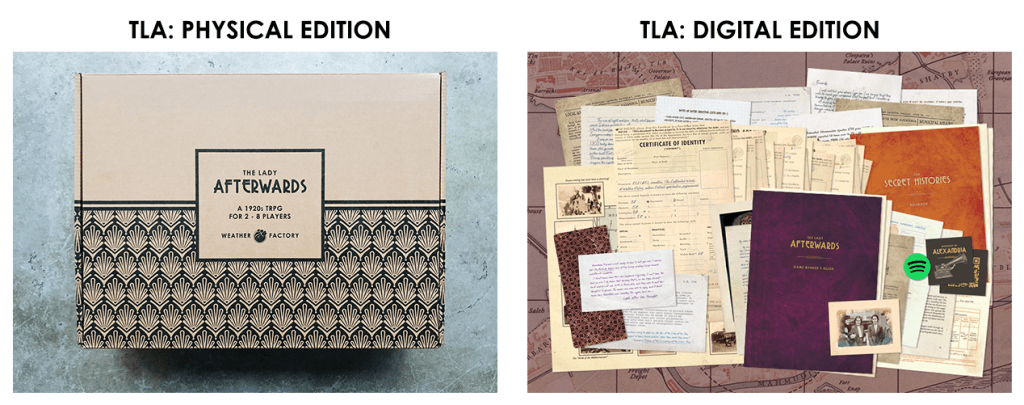
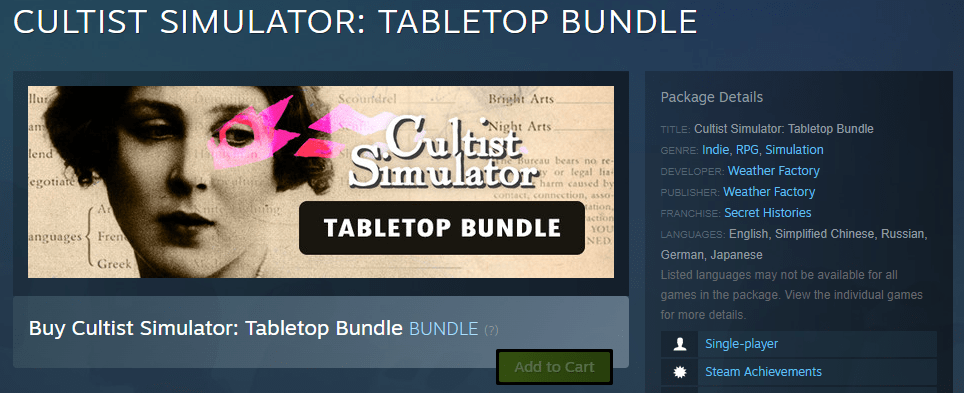
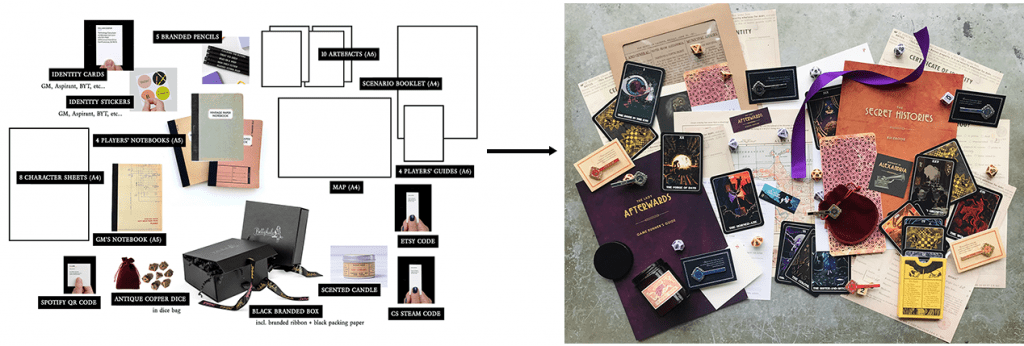
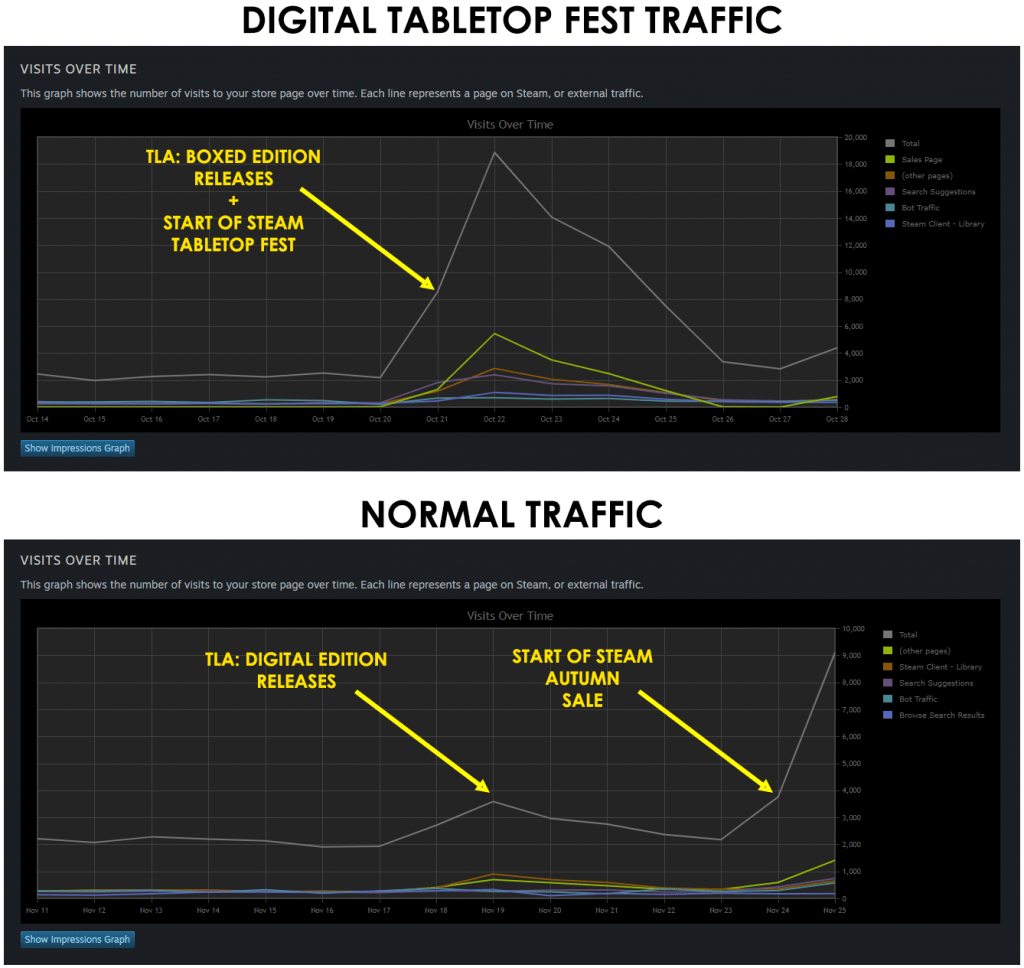
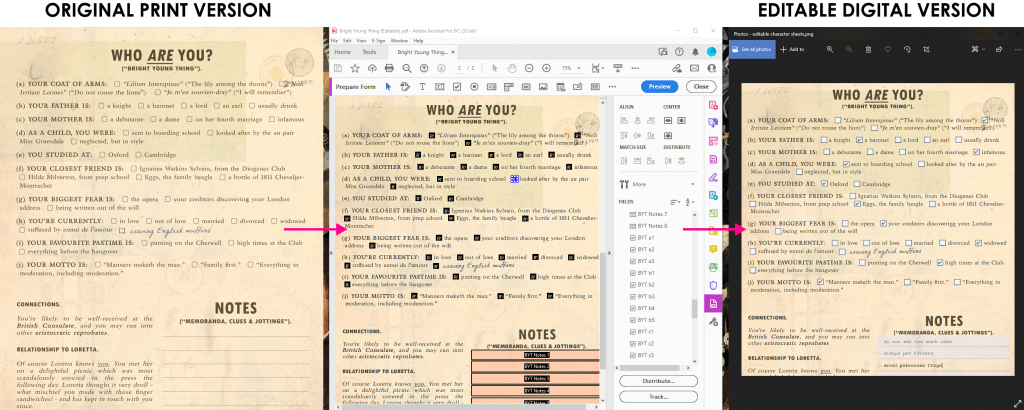


Thanks for the peak behind the curtain, it’s always fascinating to see the numbers behind a launch! But as a clueless layman in terms of budgeting, how did you guys come up with the number 100 for the physical edition? I mean, putting 30k into development to then sell 100 boxes a 150 a pop… let’s just say my accountant would’ve told me he’d like a word and most of those words he would’ve liked would contain an awful lot of curses and insults xD
I have a request and a suggestion! I’m not 100% certain of the etiquette here, but I’m pretty sure this is rude, so please feel free to ignore me totally.
The request: please do a digital edition of your hours tarot cards: I’d happily pay for that and it would make running TLA online much easier, I feel (since using normal tarot cards when I know there are better, more specific ones makes me unhappy).
The suggestion: you could do a Tabletop Simulator expansion for TLA. You would probably want to hire somebody who’s done that before to do it, but there are a lot of very much more ambitious TTS expansions and mods, so I’m sure you could find somebody. (Not coincidentally, I own TTS and this would necessitate a digital version of the Tarot of the Hours…)
I’d also like to +1 on the digital tarot cards. I’m in the process of playing through TLA on Roll20. They have a lot of features to play tabletop games online and one of the features is creating a custom deck of cards that you can draw from. I was able to hunt down all the card images online, but I was really hoping to have those provided somehow. I would have also been fine with paying for a digital version of the tarot as well if it was a separate purchase or something.
Also, (minor suggestion) a completely blank version of the character sheet without the hand written elements and the character class left blank. Specifically the skills page. I’m not sure how other online platforms for TRPGs work but, Roll20 allows games to have 1 custom character sheet template, and the ones provided are unique to each character. A blank universal skills page would allow me to create a custom template on roll20 and use the lovely character sheet art. Again, really minor, I just had my players end up sending me their character sheets after they filled them out and I’ve been pulling them up manually and it hasn’t posed a problem.
The game is great though! My friends and I have been having a great time playing through the campaign so far 🙂
What a great read! Thanks for taking the time to put this together!